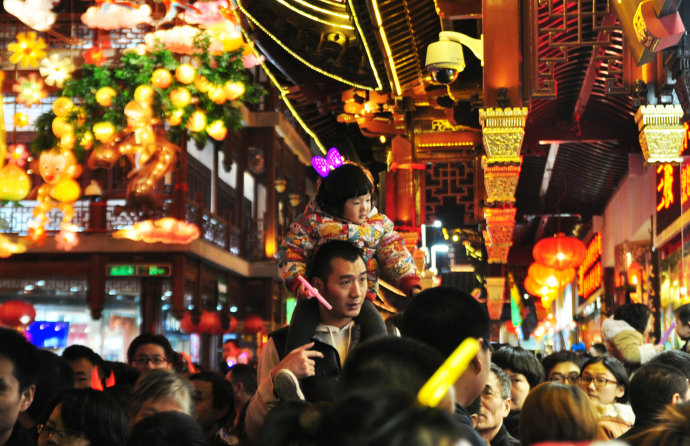Customs on the first full moon of the year

People visit the 2017 Yuyuan Spring Folk Artistic Lantern Festival Fair to experience local festive customs.
The first full moon each year appears on the night of the Lantern Festival, which falls on the 15th day of the first lunar month. Diverse customs began emerging on this day as early as the Sui Dynasty (581-618), giving the festival distinct cultural characteristics. Over time, these activities multiplied. During the festival, people gaze at the moon and lanterns, tell and guess the answers to riddles, set off fireworks and perform the Dragon Dance.
Pray for family, harvest
During the festival, people pray for good fortune for their family members and for a good harvest in the coming year.
These familial prayers have a close relationship with lanterns. Lights are usually considered the symbol of life. In traditional Chinese language, the characters for lights and population are similar in pronunciation and appearance.
People use different methods to pray for family members across China but they are all similar wishes. For example, parents in Chengdu, Sichuan Province buy a delicate table light and a small mouse made of dough and send them to their daughters who have just gotten married. It is believed that families will have more children if they undertake these activities.
People also perform activities to pray for rural abundance during the Lantern Festival, such as the Dragon Dance. Harvests require good weather, which is said to be controlled by dragons. The Dragon Dance aims to wake the long dragon who sleeps in the deep ocean in winter to bring about rainfall, thus benefiting crops and people.
Joyful event
In ancient China, the sleep cycle was changed for the Lantern Festival.
People changed their daily routine entirely on this particular day. This is because the highlights of the event arrive at night, so people don’t lie down and sleep after sunset as usual. Instead, they choose to leave their homes to participate in diverse activities lasting throughout the whole night.
This was in many ways possibly because of support from the emperor. During various dynasties, people could have a day off work on the day of the Lantern Festival and the holiday tended to grow throughout the ages. Emperor Xuanzong of the Tang Dynasty permitted one day off and Emperor Shenzong of the Song Dynasty allowed seven days off. In the Ming Dynasty, Emperor Taizu extended the holiday to 10 days. Curfews were also cancelled during festivals. China instituted curfews in cities in ancient times, but people could go out at night during Lantern Festival as of the Sui and Tang dynasties.
Daily activities on this occasion were transformed in other ways as well. Farmers who usually had to stay in villages could flow into cities. Urban residents could go to any place they want at night rather than obey curfews. These constraints were abolished during the Lantern Festival because celebrations could only be carried out on streets, squares and other outdoor spaces.
The event is so anticipated that New Year’s Eve celebrations are not as diverse as this night. The night is decorated by the full moon, colorful fireworks and various lanterns. The streets are filled with diverse performances, delicate dances and large crowds.
Moreover, the festival tears down the prohibitions of social norms. In traditional Chinese society, legal institutions and civil customs all emphasized the boundaries between urban and rural areas, the differences between the wealthy and the poor as well as the habit of frugalness. However, the Lantern Festival set these norms aside, giving people amounts of freedom that were rare at the time.
